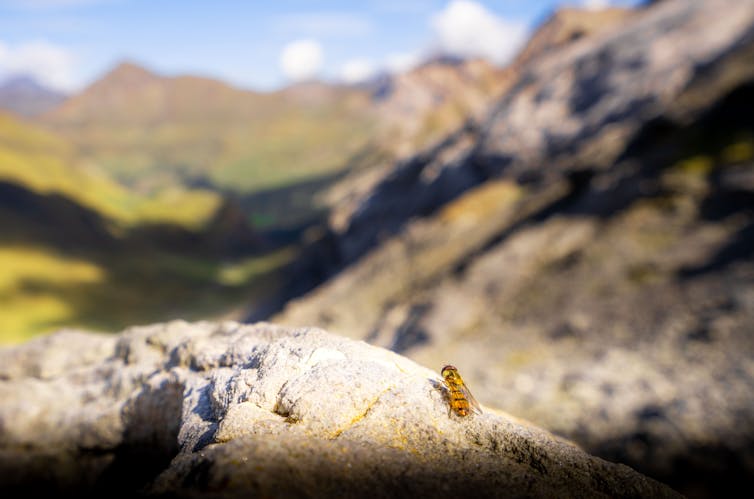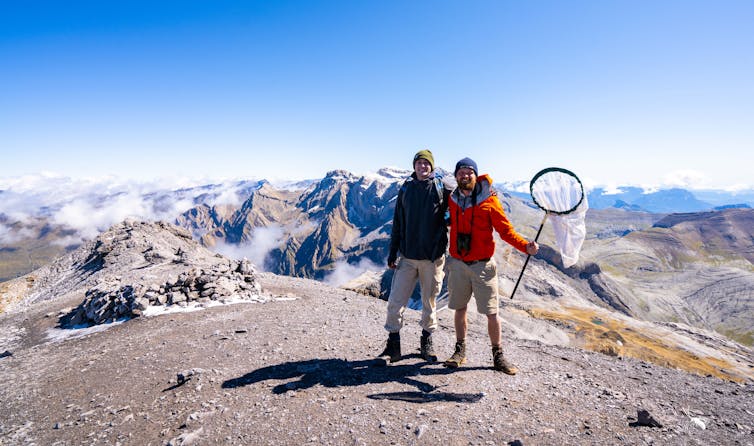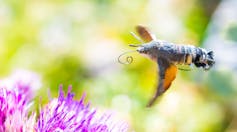
I surveyed 17 million insects flying through a Pyrenean mountain pass – here’s what I learned about these ‘remarkable migrants’
Will Hawkes, CC BY-ND
Will Hawkes, University of Exeter
In 1950, ornithologists Elizabeth and David Lack were watching birds migrate through a Pyrenean mountain pass on the border between France and Spain when they stumbled across something extraordinary – uncountable numbers of migrating insects. The Lacks were the first people to record fly migration in Europe. Despite only being in the pass for a single day, they labelled these insects “the most remarkable migrants of all”.
Seventy years on, I’ve been calculating the numbers of insects migrating through this same 30m-wide mountain pass of Bujaruelo, 2,500m above sea level, as part of my research with the insect migration team from the University of Exeter. Our new study highlights that, across the autumn field season throughout September and October, more than 17 million insects migrate through this pass.
In the intense late September heat, even the hardy mountain sheep were lying with their heads under rocks for shade. As I stood with my insect net in hand, the number of butterflies flying past me ramped up until I was engulfed in a snowstorm of cabbage whites and clouded yellows, all migrating southwards through the pass.
Later in the day, I noticed small creatures zipping past my feet as if the ground had become a living carpet, humming with energy. Swinging my net again, I trapped at least 20 flies in a single swipe – from minuscule 3mm-long grass flies to house flies and the gorgeous marmalade hoverfly. All were moving purposefully southwards.

With far too many insects for me to count by eye, we used a small video camera to calculate accurate migration numbers. These videos showed that, at their peak, more than 3,500 flies were migrating through each metre width of the mountain pass every minute. That’s around 105,000 flies moving through the 30-metre-wide pass every 60 seconds – more than the seating capacity of Wembley Stadium.
The insects flying south from mainland Europe and Britain total tens or hundreds of trillions – of which 17 million travel through this pass, according to our calculation. As they soar over the plains of Europe, they use the Sun as a compass to orientate themselves and choose favourable winds to power their journeys. Eventually, they reach the great geographic barrier of the Pyrenees mountains, which is too high for them to easily fly over.
Instead, they are funnelled by the steep-sided valleys through the mountain passes. After the Pyrenees, they fly down through Spain and perhaps beyond into Africa, searching for a suitable habitat to overwinter and continue to reproduce. Their journeys could easily exceed 1,000km and are comparable to the migrations of birds – truly remarkable for such miniscule creatures.
Alongside quantifying their numbers, I’ve been working hard to identify the entire insect assemblage migrating through this mountain pass. During the day, I placed a large stationary net in the pass to collect a sample of the insects. These nets collected samples for two months each autumn for four years, and we identified a diverse array of insects migrating.
Before embarking on this fieldwork, my PhD supervisor Karl Wotton and I had expected butterflies or dragonflies would be the most abundant, because these insects seem most frequently mentioned in news headlines about insect migration. However, these two groups only made up 2% of the total number of migratory insects that we identified.
Instead, flies dominated every survey and sample. Nine out of every ten insects captured were flies. Even when the sky looked clear, I’d sweep my net across and capture a myriad of miniscule flies – the air was full of magic.

Long-distance influencers
Once we know which insects are migrating, we can better understand their impact on the world. Most (nearly 90%) of these insects are pollinators – including the tiny marmalade hoverfly and much larger hummingbird hawkmoth. Because they are migrants, these insects can move pollen – and the genetic material stored inside – many kilometres, linking geographically isolated plant populations. This improves the genetic diversity of the plants, and can even transfer genes for dealing with more adverse conditions such as drought.
Some insects are pests that damage crops, but many others are pest controllers – such as the marmalade and Eupeodes hoverflies, whose larvae eat an average of 6 trillion aphids each year in southern Britain alone. Some insects, such as drone hoverflies, are decomposers that help break down organic waste.

All these insects play a role in transporting nutrients – their bodies contain phosphorous and nitrogen that can act as fertiliser and aid plant growth. When the insects die, these nutrients are absorbed into the ground, helping to maintain and improve soil health.
Of course, our much-loved garden birds rely on many of these insects as food. Birds that don’t migrate, such as robins and bluetits, feed on insects during the summer months. Migratory birds such as chaffinches, goldfinches and swallows eat insects on the wing as they fly through locations such as this Pyrenean mountain pass.

However, due to the climate crisis and habitat loss, some of these insect migrants – particularly pollinators – are declining. A recent study suggests there has been a 97% decline in aphid-eating migratory hoverflies over the last 50 years in Germany – and this could well be happening in the Pyrenees too. Given what we know about the ecological benefits of these insects, this is a terrible loss.
The number of insects we saw migrating was incredible, but still probably not as high as when the Lacks visited these mountains in 1950, because of climate change, pesticide use and habitat loss.
That said, insects are resilient and can bounce back quickly. By putting pressure on policymakers to create more wildlife-friendly habitat, eating more organic food and gardening with bugs in mind, we can protect these most remarkable migrants of all.
Will Hawkes, Insect Migration Researcher, DEPT, University of Exeter
This article is republished from The Conversation under a Creative Commons license. Read the original article.
